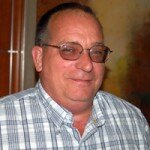
Almost three years ago, Richard “Dick” Watson, MD, found himself in an unfamiliar position for a doctor: lying on the operating table instead of standing over it. He didn’t know it at the time, but it was the beginning of a journey that would take him from intensive physical therapy to being recertified to be a physician— not bad for someone who had suffered two ruptured brain aneurysms.
Watson, 68, is a longtime Cincinnati physiatrist (specialist in physical medicine and rehabilitation) who worked at The Christ Hospital for 30 years and ran the Mercy Health Mt. Airy rehab unit for the last eight years of his career. He met his wife, Shelagh, a physical therapist, at Christ.
On Sept. 24, 2011, Watson experienced a massive headache at the couple’s Northern Kentucky home. They went to Christ Hospital, where the decision was made to send him to the Neuroscience Intensive Care Unit (NSICU) at University of Cincinnati Medical Center. There, he was found to have two ruptured posterior brain aneurysms resulting from stenosis of the right vertebral artery.
Mario Zuccarello, MD, UC Health and Mayfield Clinic neurosurgeon and the Frank H. Mayfield Chair for Neurological Surgery at the UC College of Medicine, determined that Watson was in a difficult situation, made even more difficult by his history of cardiovascular disease. Surgery was delayed by the search for a solution, and Zuccarello told Watson’s family members that he had only about a 10 percent chance of surviving the week.
“All of his medical friends who visited him in the NSICU thought that he wouldn’t make it,” Shelagh Watson recalls.
On Day 13, Watson went into surgery for a bypass—specifically, an external carotid PICA (posterior inferior cerebellar arteries) bypass, a procedure Zuccarello helped pioneer. Todd Abruzzo, MD, UC Health and Mayfield Clinic interventional neuroradiologist and Associate Professor of Neurosurgery, Radiology and Biomedical Engineering, subsequently coiled the aneurysms. Watson also had a shunt implanted. He spent 26 additional days at UC Medical Center before being transferred to Daniel Drake Center for Post-Acute Care.
At Drake, Watson—who had received a tracheostomy tube while at UC Medical Center—was in a ventilator ward for 25 days before going to rehab. He was discharged Dec. 15, 2011, but still faced many months of physical and speech therapy that brought him back to, in his wife’s words, “almost as good as new.”
He subsequently passed his driving test and recertification to be a physician, but chose to retire in March 2012. “He was having too much fun to go back to work,” Shelagh Watson says. Since Watson’s recovery, they have enjoyed retirement and spending time with family and friends.
Shelagh Watson has good memories of the couple’s time at UC Medical Center and the talented and caring staff they encountered there. The couple has returned several times to thank the staff of the NSICU.
“The minute I walked into UC Medical Center I was greeted by people who didn’t even know me, but even in my darkest moments they would say hello to me,” she says. The staff was exceptionally kind, recognizing my pain and my despair—that meant the world to me.”
As for the medical care Richard Watson received, he says it was “just the highest quality we could have ever hoped for—we were very fortunate to be in Cincinnati when this happened and to receive care from doctors and staff with God-given talent who saved my life.”
In an interesting coincidence, Shelagh Watson’s father was the late Colin Macpherson, MD, who was a leader in the pathology and laboratory medicine community in Cincinnati, UC College of Medicine faculty member and professor emeritus of clinical laboratory science and medical technology in UC’s College of Allied Health Sciences. The Dr. Colin R. and Margaret E. Macpherson Scholarship in the College of Allied Health Sciences is named in his honor.
Macpherson served in several capacities at UC Medical Center, and Shelagh Watson says he and her husband had a friendly competition. “As it turned out, it was my father’s hospital that saved my husband’s life,” she says.







